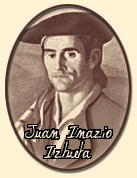 |  | The pigeon wings are performed as follows: Lifting the right foot and keeping it well extended behind with the tip pointing downwards, [the dantzari] has to hit it with the left foot first below and then on top, as if he were performing a leap, and then only places his right foot on the floor. Stretching out the tip of the left foot, which is held in the air, the dancer positions it behind and hits it with the right foot first below and then on top, as he did with the other foot, and then only places his left foot on the floor. These are two pigeon wings. The dantzari may thus perform as many pigeon wings as he desires, but they are always to be symmetrical, so that he has to do as many with his left foot as his right, so that the audience cannot criticises him for letting his left leg take over. |  |


